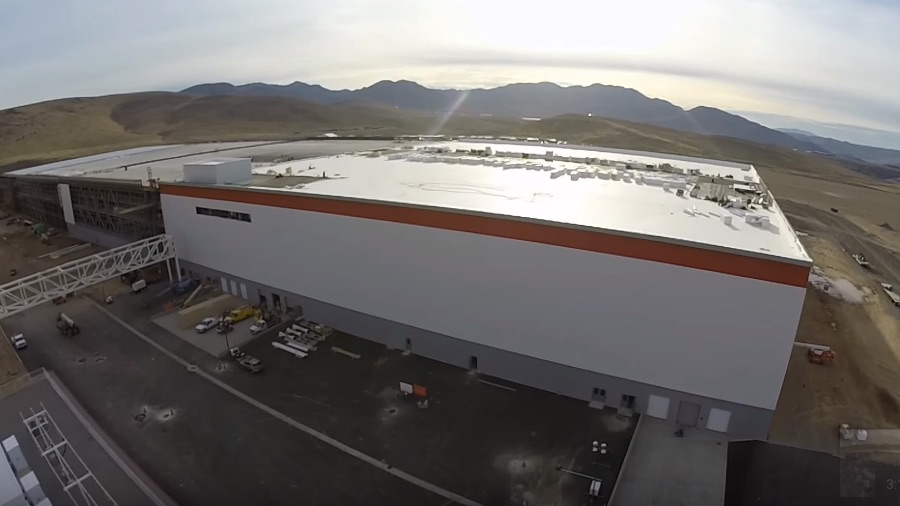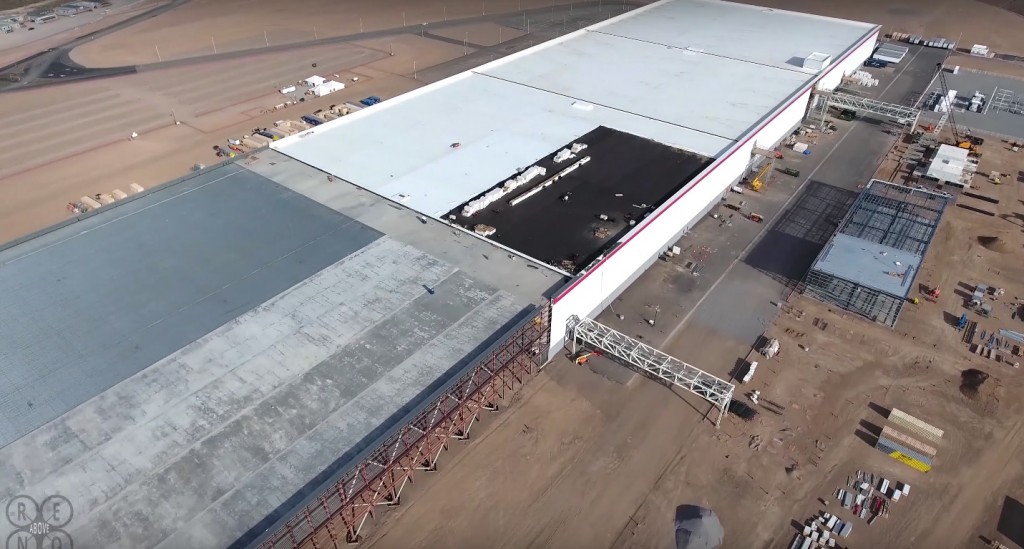News
Top 6 tidbits about Tesla’s Gigafactory revealed through building permits

It’s no secret that Tesla’s $5 billion dollar Gigafactory 1 located just east of Reno, Nevada will be a critical component to the company’s goal of scaling mass production of batteries for its upcoming Model 3 and Tesla Energy product line. We know the Gigafactory will be one of the largest buildings in the world projected to occupy 13.6 million square feet, and we know the factory will be powered by renewable energy sources, with the goal of achieving net zero energy. However, construction permits filed by Tesla provide even more interesting insight to Gigafactory 1 that you may not already know.
Here are the top 6 tidbits of Tesla’s Gigafactory as revealed through building permits received by Tesla. Information is provided courtesy of analyst Jack Cookson of BuildingZoom.
1) July 29 launch event attendees may witness battery cells being made
Construction permit #0934363 indicates that the $51 million dollar “Battery Cell Manufacturing Equipment Installation” project is estimated to be complete on July 20th. This means that attendees of the highly anticipated July 29 Gigafactory ‘Grand Opening’ event may actually have the opportunity to see battery cells being manufactured.
2) Tesla can do it all
Tesla filed for building permits themselves as opposed to using a General Contractor. According to a report put together by Cookson of BuildZoom,
“Something we found different about this project is that Tesla filed the majority of their own building permits and is actually the contractor for the project. This means, that Tesla had to acquire a contractor license in Nevada and has taken on far more work than if they had just hired a General Contractor.”
This may not be such a bad idea considering Tesla’s recent involvement in a foreign worker scandal under poor supervision and management by factory sub-contractors.
3) Tesla’s Gigafactory is designed for earthquakes
Most buildings rest on a single foundation, however the enormous rectangular shaped Gigafactory rests on four individual foundations. This is designed so that each section of the building can shift independently of one another in the event of an earthquake.
4) The Gigafactory doesn’t stop growing
Tesla received a permit to expand the Gigafactory with a 4th Area ‘D’ and 5th Area ‘E’. The $63 million dollar D and E project is scheduled to be complete by the end of the year. Tesla’s enormous Gigafactory is currently only 14% of the total planned floor space, but will reach an astounding 13.6 million square feet when complete.

Overhead view of Area ‘D’ captured by drone in April 2016
5) Tesla donated a fire truck to the local fire department
Tesla spent a total of $4.7 million dollars on fire safety, including a permit for a fire command center. Part of that included a donation of a fire engine to the local Storey County, Nevada fire station.
6) Giant refrigerator + water tank twice the size of an olympic pool
1 of the 84 permits filed indicates that the Gigafactory will have a giant chiller yard which will presumably be used for testing batteries while keeping them in a cool state.
The factory also has a a 1.5 million gallon water tank on site that is more than twice the size of an olympic sized swimming pool. Details within the permit do not indicate what this water tank will be used for.

News
Tesla starts showing how FSD will change lives in Europe
Local officials tested the system on narrow country roads and were impressed by FSD’s smooth, human-like driving, with some calling the service a game-changer for everyday life in areas that are far from urban centers.

Tesla has launched Europe’s first public shuttle service using Full Self-Driving (Supervised) in the rural Eifelkreis Bitburg-Prüm region of Germany, demonstrating how the technology can restore independence and mobility for people who struggle with limited transport options.
Local officials tested the system on narrow country roads and were impressed by FSD’s smooth, human-like driving, with some calling the service a game-changer for everyday life in areas that are far from urban centers.
Officials see real impact on rural residents
Arzfeld Mayor Johannes Kuhl and District Administrator Andreas Kruppert personally tested the Tesla shuttle service. This allowed them to see just how well FSD navigated winding lanes and rural roads confidently. Kruppert said, “Autonomous driving sounds like science fiction to many, but we simply see here that it works totally well in rural regions too.” Kuhl, for his part, also noted that FSD “feels like a very experienced driver.”
The pilot complements the area’s “Citizen Bus” program, which provides on-demand rides for elderly residents who can no longer drive themselves. Tesla Europe shared a video of a demonstration of the service, highlighting how FSD gives people their freedom back, even in places where public transport is not as prevalent.
What the Ministry for Economic Affairs and Transport says
Rhineland-Palatinate’s Minister Daniela Schmitt supported the project, praising the collaboration that made this “first of its kind in Europe” possible. As per the ministry, the rural rollout for the service shows FSD’s potential beyond major cities, and it delivers tangible benefits like grocery runs, doctor visits, and social connections for isolated residents.
“Reliable and flexible mobility is especially vital in rural areas. With the launch of a shuttle service using self-driving vehicles (FSD supervised) by Tesla in the Eifelkreis Bitburg-Prüm, an innovative pilot project is now getting underway that complements local community bus services. It is the first project of its kind in Europe.
“The result is a real gain for rural mobility: greater accessibility, more flexibility and tangible benefits for everyday life. A strong signal for innovation, cooperation and future-oriented mobility beyond urban centers,” the ministry wrote in a LinkedIn post.
News
Tesla China quietly posts Robotaxi-related job listing
Tesla China is currently seeking a Low Voltage Electrical Engineer to work on circuit board design for the company’s autonomous vehicles.

Tesla has posted a new job listing in Shanghai explicitly tied to its Robotaxi program, fueling speculation that the company is preparing to launch its dedicated autonomous ride-hailing service in China.
As noted in the listing, Tesla China is currently seeking a Low Voltage Electrical Engineer to work on circuit board design for the company’s autonomous vehicles.
Robotaxi-specific role
The listing, which was shared on social media platform X by industry watcher @tslaming, suggested that Tesla China is looking to fill the role urgently. The job listing itself specifically mentions that the person hired for the role will be working on the Low Voltage Hardware team, which would design the circuit boards that would serve as the nervous system of the Robotaxi.
Key tasks for the role, as indicated in the job listing, include collaboration with PCB layout, firmware, mechanical, program management, and validation teams, among other responsibilities. The role is based in Shanghai.
China Robotaxi launch
China represents a massive potential market for robotaxis, with its dense urban centers and supportive policies in select cities. Tesla has limited permission to roll out FSD in the country, though despite this, its vehicles have been hailed as among the best in the market when it comes to autonomous features. So far, at least, it appears that China supports Tesla’s FSD and Robotaxi rollout.
This was hinted at in November, when Tesla brought the Cybercab to the 8th China International Import Expo (CIIE) in Shanghai, marking the first time that the autonomous two-seater was brought to the Asia-Pacific region. The vehicle, despite not having a release date in China, received a significant amount of interest among the event’s attendees.
Elon Musk
Elon Musk and Tesla AI Director share insights after empty driver seat Robotaxi rides
The executives’ unoccupied tests hint at the rapid progress of Tesla’s unsupervised Robotaxi efforts.

Tesla CEO Elon Musk and AI Director Ashok Elluswamy celebrated Christmas Eve by sharing personal experiences with Robotaxi vehicles that had no safety monitor or occupant in the driver’s seat. Musk described the system’s “perfect driving” around Austin, while Elluswamy posted video from the back seat, calling it “an amazing experience.”
The executives’ unoccupied tests hint at the rapid progress of Tesla’s unsupervised Robotaxi efforts.
Elon and Ashok’s firsthand Robotaxi insights
Prior to Musk and the Tesla AI Director’s posts, sightings of unmanned Teslas navigating public roads were widely shared on social media. One such vehicle was spotted in Austin, Texas, which Elon Musk acknowleged by stating that “Testing is underway with no occupants in the car.”
Based on his Christmas Eve post, Musk seemed to have tested an unmanned Tesla himself. “A Tesla with no safety monitor in the car and me sitting in the passenger seat took me all around Austin on Sunday with perfect driving,” Musk wrote in his post.
Elluswamy responded with a 2-minute video showing himself in the rear of an unmanned Tesla. The video featured the vehicle’s empty front seats, as well as its smooth handling through real-world traffic. He captioned his video with the words, “It’s an amazing experience!”
Towards Unsupervised operations
During an xAI Hackathon earlier this month, Elon Musk mentioned that Tesla owed be removing Safety Monitors from its Robotaxis in Austin in just three weeks. “Unsupervised is pretty much solved at this point. So there will be Tesla Robotaxis operating in Austin with no one in them. Not even anyone in the passenger seat in about three weeks,” he said. Musk echoed similar estimates at the 2025 Annual Shareholder Meeting and the Q3 2025 earnings call.
Considering the insights that were posted Musk and Elluswamy, it does appear that Tesla is working hard towards operating its Robotaxis with no safety monitors. This is quite impressive considering that the service was launched just earlier this year.








